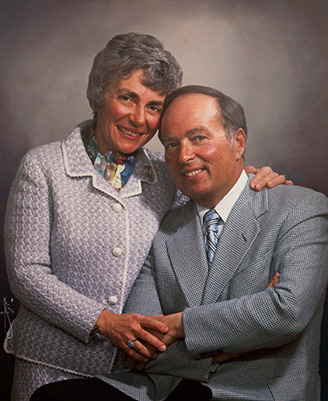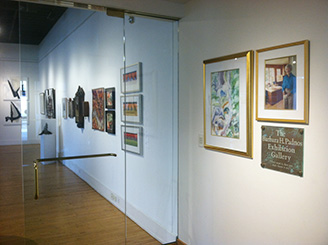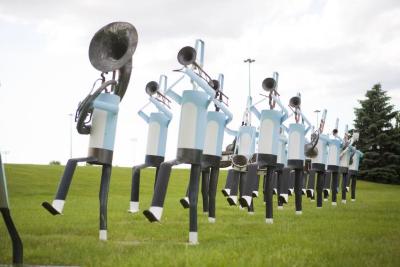Stuart and Barbara Padnos as Collectors
Ellen Adams, Assistant Professor, Frederik Meijer Honors College
There are people who collect art to increase their cultural capital. Others may amass holdings of art as an investment or as a competitive endeavor (think of hedge fund bidders at recent contemporary auctions). Some only acquire artworks from specific periods or by a small group of artists to form a focused compilation. Then there are those collectors who bring together works of art out of pure love and enthusiasm, assembling collections based on personal history and ceaseless curiosity. This last description certainly applies to Stuart and Barbara Padnos. Shared Passion: A Gift of the Stuart & Barbara Padnos Foundation Collection celebrates nearly thirty years in the collecting life of this husband and wife. The paintings, drawings, watercolors, prints and sculptures in this collection enhanced the Padnos home, enriched their family life, and captivated visitors for decades. Yet the process of collecting reveals much about Stuart and Barbara’s evolving tastes and their unending desire to learn about new artists and processes. Both artists in their own right, the pair accumulated objects that reflect their distinct backgrounds and mutual affinities.
Stuart Padnos, son of a Russian Jewish immigrant, was born in Grand Rapids, Michigan, in 1922 and lived his entire life in nearby Holland. As a teen he worked for Louis Padnos Iron and Metal Inc., the company founded by his father, whose work ethic Stuart adopted. He served as a corporal in the Army infantry during World War II, and spent five months as a prisoner of war after having been captured during the Battle of the Bulge. At war’s end, he rejoined his father’s business, where he thrived as an executive and entrepreneur. Stuart’s dedication to his business and employees extended to the greater Holland area as well as to the Jewish community in West Michigan. “Being members of a minority in a community,” recalled his son, Jeff Padnos, “there was always a desire to be a good example of his faith, and he also instilled in all of us a sense of obligation to look out for other people …” For Stuart, this commitment included the support of such organizations as the Boys & Girls Club of Greater Holland, the Holland Area Arts Council, the Jean & Samuel Frankel Center for Judaic Studies at the University of Michigan, Grand Valley State University (where he served on the Advisory Cabinet for the Grand Valley University Foundation Board of Directors) and other local and regional associations.
Such generosity formed the foundation of a shared purpose with his wife. Barbara was a native of Boston and attended Mt. Holyoke College. The pair first met when the army sent Stuart to school in the Massachusetts capital; they reunited after the war, married and settled in Michigan. Despite her strong East Coast roots, Stuart recalled Barbara’s swift acclimation to Holland through community involvement with “the Garden Club, the Literary Club, and [as] president of Junior League. She was on the original board of Community Action House. … She was active in our temple in Grand Rapids …”1 Her wide-ranging avocations also included art – as a practicing artist, patron, and advocate. An accomplished watercolor painter who later took up printmaking, Barbara engaged with the visual and musical arts from her earliest years. Once she moved to Michigan, she served on the board of the executive committee of the Grand Rapids Art Museum, and according to her husband, was instrumental in the Holland Area Arts Council: “Part of the reason that I donated the room at the Arts Council [the largest gallery is named for Barbara] was that I feel very strongly, and I think very accurately, that there would not be an Arts Council of any consequence if she hadn’t been there.”
Barbara’s passion for art, as for all of her interests, enlivened those around her. Daniel Padnos recalls that his mother frequently took her children “to community concerts to hear solo violinists, solo pianists” and stimulated his own interest in art collecting.2 Stuart credited Barbara, whom he called his “major shining star,” as the inspiration for his own artwork, their collection, and their patronage of the visual arts. Without her influence, he recalled,
I would never have gotten into the arts, I would never have gotten anything artistic. I wouldn’t have gone to art museums. I wouldn’t have been an art collector. I wouldn’t be an artist if I am one, had it not been for my wife’s guiding hand.
Stuart clearly followed Barbara’s lead and together the couple began to hone their artistic tastes, a process that led to their first acquisitions. Stuart often traveled for business, and on the occasions when Barbara accompanied him, she “would always want to take time to go to museums and galleries in these cities,” recalls son Doug Padnos.3 Early works entered the Padnos collection through Hammer Galleries in New York, a well-established (and well-heeled) gallery that dealt primarily in European and American masters. The initial connection with Hammer occurred through a case of mistaken identity. Generally, the couple would peruse galleries and not attract a great deal of attention. During one visit, however, one of Hammer’s dealers erroneously believed that he recognized Stuart from the Army. The two men struck up a conversation, and over the next several years Frederic Seligman took Stuart and Barbara under his wing and served as trusted educator and advisor, deepening the couple’s understanding of art and expertly guiding their purchases. On occasion, some pieces were priced outside of their financial reach. Seligman offered these to Stuart and Barbara on a payment plan — a customary practice — in order to unite the collectors with works they simply had to have.
Objects entered the Padnos home over the course of several decades, starting in the early 1970s. Their first purchase was considered such an auspicious occasion that it warranted family involvement, which helped to set the stage for their children’s embrace of art collecting. Daniel recalls one evening after they had finished watching the nightly Huntley-Brinkley Report, Stuart declared there would be a “policy announcement” following dinner. Generally, such decrees addressed mundane but nonetheless important domestic matters (such as a ban on Mad magazine). This time was different. Stuart announced, “I’ve decided to buy a painting.” After entreaties from the family (“Which painting? By whom?”) Stuart revealed that they had purchased the Grandma Moses painting The Storm, 1955, which is now part of the Padnos Foundation gift to Grand Valley State University.4
In the three decades that followed, the profile of the collection shifted from an initial interest in two-dimensional works by established artists such as Moses to a broader array of styles and mediums. During the seventies the couple continued to visit New York and acquire American and European modern masters, much of it introduced under Seligman’s tutelage at Hammer Galleries. Among others, the couple acquired works by Vinciata (pseudonym of American painter Joseph Wallace King), Thomas Hart Benton, Fernand Renard, Paul Signac, Eugène Boudin, Jean Dufy, Raoul Dufy and Edouard Léon Cortès. Their early concentration on modern French art was typical for novice American collectors; moreover, their interest in traditional American work bucked current trends in contemporary art (an approach they would later reverse). Starting in the 1980s and buoyed by an increasing awareness of art and shifting preferences, the couple delved into three-dimensional work and acquired table-top and larger free-standing sculptures by George Kafka, Mario Negri, Judith Brown, Alvar Suñol Munoz-Ramos, Richard Erdman and Allan Houser. They also expanded beyond Seligman’s guidance at Hammer to purchase works from galleries in Montreal, Chicago, Park City, and Santa Fe during trips for business and pleasure. During their last decade of collecting, Stuart and Barbara broadened their tastes by attending art fairs (such as Art Chicago) and traveling more extensively. They purchased works by Grand Rapids artist Mathias Alten, William Samuel Schwartz, Aurora Cañero, Henri Matisse and, branching out into more conceptual art, bought contemporary sculptures by Grisha Bruskin and Nicola Hicks.
While the mix of artists in the Padnos collection may seem on the surface to be quite eclectic, distinct trends emerge. Barbara and Stuart’s own artwork influenced, and, in turn, was influenced by the work they collected. An emphasis on works on paper, seen in the profusion of prints, watercolors, and drawings, ties directly to Barbara’s own work as an artist, and her watercolors and woodcuts hung interspersed among the collected pieces in their home. Stuart’s sculptures, such as Marching Band; (which he donated to GVSU and occupies a prominent place on campus), reused and recycled discarded metal from the Louis Padnos company. Similarly, works like Judith Brown’s Duo incorporate found materials such as the twisted remnants of automobiles and other detritus. Brown also used castoff materials to create Jewish ceremonial objects, which suggests another strong current in the Padnos collection — an assortment of artists in whose work a distinct Jewish heritage and imagery play a significant role. This includes, among others, Marc Chagall, Jack Levine, Schwartz and Pissarro; several contemporary menorahs also augmented their collection. Finally, Stuart and Barbara’s love of sailing steered their choice of certain pieces. Stuart had been a junior member of the Macatawa Bay Yacht Club and later his family became among its first Jewish members. Barbara broke barriers by starting women’s sailing at the Yacht Club and skippered the women’s team in nationals. A profusion of works represent their passion for the sport; with harbor scenes, seascapes, and a variety of boats represented by Alten, Cañero, Raoul and Jean Dufy, Childe Hassam, Pissarro, Signac and Sam Thal.
Stuart and Barbara lovingly assembled this broadly based collection over the course of
three decades.
They prioritized collecting works of art and devoted time and resources to learning as much as they could about the art and artists. Stuart’s energetic drive to educate visitors to his home — he loved to answer questions about the collection and explain the context of the works — extends to the mission of this generous gift to Grand Valley State University. Students, staff, faculty, and visitors to the university now benefit from the labor of love undertaken by Stuart and Barbara Padnos.
References
- Wagenaar, Larry, “Padnos, Stuart Oral History Interview: Sesquicentennial of Holland, 150 Stories for 150 Years,” Sesquicentennial of Holland, 150 Stories for 150 Years, Paper 93 (1997). http://digitalcommons.hope.edu/ses_holland/93/ All quotes from Stuart Padnos come from this document.
- Author interview with Daniel Padnos, June 13, 2014. All quotes from Daniel Padnos come from this interview.
- Author interview with Doug Padnos, June 19, 2014. All quotes from Doug Padnos come from this interview.
- Stuart and Barbara Padnos likely viewed the work as part of Hammer’s earliest exhibitions of Moses’ paintings.



Marching Band
